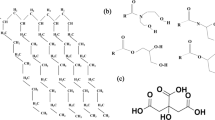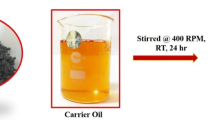Abstract
As a kind of new MR material, MR gel (MRG) can be regard as the analog of MRF, which can overcome the iron particles sedimentation and unstable application of MRF especially in recoil of gun. However, some major parameter of this kind of MRG, such as the initial modulus, magneto-induced shear storage modulus and relative MR effect are relatively small, which cannot meet the need the application in recoil of gun. In this work, an MRG with high magneto-induced shear storage modulus, relative MR effect and suitable initial modulus has been fabricated by controlling the mass fraction of carbonyl iron powder (CIP) under specific crosslinking degree of polyurethane (PU) matrix. And several PU-based MRG composites with the CIP mass fraction of 40, 60, 80% were prepared. The dynamic mechanical property of those MRG samples ware researched through an advanced commercial rheometer. The experimental results indicated that magneto-induced modulus and relative MR effect in sample 2 (containing 60 wt% of CIP) were approximately 2.87 and 2.32 times than sample 1 (containing 40 wt% of CIP), 1.67 and 2.97 times than sample 3 (containing 80 wt% of CIP). Moreover, the samples have good consistency in transient response under the step magnetic field. The high magneto-induced modulus of sample 2 can be mainly attributed to the following point. Appropriate amount of PU polymer chain can reinforce the binding force between CIPs in the chain and better constrained particle motion under magnetic field. It is concluded that this study provides a meaningful way to improve the mechanical properties of MRG and expected to promote the application of MRG in recoil of gun.











Similar content being viewed by others
References
P. Yang, M. Yu, J. Fu, Ni-coated multi-walled carbon nanotubes enhanced the magnetorheological performance of magnetorheological gel. J. Nanopart. Res. 18(3), 61 (2016)
H. Pang, S. Xuan, C. Sun et al., A novel energy absorber based on the magnetorheological gel. Smart Mater. Struct. 26(10), 105017–105038 (2017)
P.V. Rao, S. Maniprakash, S.M. Srinivasan et al., Functional behavior of isotropic magnetorheological gels. Smart Mater. Struct. 19(19), 085019 (2010)
P. Dhar, A. Katiyar, A. Pattamatta et al., Anomalous room temperature magnetorheological behavior of colloidal graphene nanogels. Colloids Surf. A Physicochem. Eng. Aspects 530, 218–226 (2017)
P. Yang, M. Yu, J. Fu et al., Rheological properties of dimorphic magnetorheological gels mixed dendritic carbonyl iron powder. J. Intell. Mater. Syst. Struct. 29(1), 12–23 (2017)
B. Hu, A. Fuchs, S. Huseyin et al., Supramolecular magnetorheological polymer gels. J. Appl. Polym. Sci. 100(3), 2464–2479 (2010)
M. Farshad, M.L. Roux, Compression properties of magnetostrictive polymer composite gels. Polym. Test. 24(2), 163–168 (2005)
M. Ahmadian, J.C. Poynor, An evaluation of magneto rheological dampers for controlling gun. Shock Vib. 8(3–4), 147–155 (2013)
M. Ahmadian, Y.K. Ahn, Performance analysis of magneto-rheological mounts. J. Intell. Mater. Syst. Struct. 10(10), 248–256 (1999)
M.A. Hajihosseinloo, C.J. Hooke, D. Walton, Gun recoil system performance measurement and prediction. ARCHIVE Proc. Inst. Mech. Eng. Part C J. Mech. Eng. Sci. 1989–1996 (vols 203–210) 203(23):85–92 (1989)
C.J. Chen, E.O. Macagno, Fluid and thermodynamic characteristics of compressible recoil. Iowa University Progress Report (1979)
J. Zheng, Q. Ouyang, Z. Li et al., Experimental analysis of separately controlled multi coils on the performance of MR absorber under impact loading. J. Intell. Mater. Syst. Struct. 27(7), 887–897 (2016)
Q. Ouyang, Z. Li, J. Zheng et al., Controllability analysis of multistage parallel magnetorheological buffer. J. Zhejiang Univ. (Engineering Edition) 51(5), 961–968 (2017)
Z.C. Li, J. Wang, A gun recoil system employing a magnetorheological fluid damper. Smart Mater. Struct. 21(10), 105003–105012(10) (2012)
Y. Xu, X. Gong, S. Xuan et al., A high-performance magnetorheological material: preparation, characterization and magnetic-mechanic coupling properties. Soft Matter 7(11), 5246–5254 (2011)
S.K. Min, Y.D. Liu, B.J. Park et al., Carbonyl iron particles dispersed in a polymer solution and their rheological characteristics under applied magnetic field. J. Ind. Eng. Chem. 18(2), 664–667 (2012)
M.J. Wilson, A. Fuchs, F. Gordaninejad, Development and characterization of magnetorheological polymer gels. J. Appl. Polym. Sci. 84(14), 2733–2742 (2002)
D. Blattman, G. Hamann, A. Fuchs, Development of Polyurethane Elastomers and Gels. In: Presented at AIChE Annual Conference (1999)
B. Wei, X. Gong, W. Jiang, Influence of polyurethane properties on mechanical performances of magnetorheological elastomers. J. Appl. Polym. Sci. 116(2), 771–778 (2010)
A. Fuchs, M. Xin, F. Gordaninejad et al., Development and characterization of hydrocarbon polyol polyurethane and silicone magnetorheological polymeric gels. J. Appl. Polym. Sci. 92(2), 1176–1182 (2010)
C. Li, Q. Taotao, X. Li et al., Preparation and application of collagen-based waterborne polyurethane retanning agent. J. Soc. Leather Technol. Chem. 101(3), 149–154 (2017)
Y. Miao, B. Ju, F. Jie et al., Magnetoresistance characteristics of magnetorheological gel under a magnetic field. Ind. Eng. Chem. Res. 53(12), 4704–4710 (2014)
J. Wu, X. Gong, Y. Fan et al., Anisotropic polyurethane magnetorheological elastomer prepared through in situ polycondensation under a magnetic field. Smart Mater. Struct. 19(10), 105007 (2010)
M. Ahmadian, R.J. Appleton, J.A. Norris, Designing magneto-rheological dampers in a fire out-of-battery recoil system. Magn. IEEE Trans. 39(1), 480–485 (2003)
H.H. Winter, F. Chambon, Analysis of linear viscoelasticity of a crosslinking polymer at the gel point. J. Rheol. 30(2), 367–382 (1986)
J.C. Ulicny, M.A. Golden, C.S. Namuduri et al., Transient response of magnetorheological fluids: Shear flow between concentric cylinders. J. Rheol. 49(1), 87–104 (2005)
T. Mitsumata, S. Ohori, Magnetic polyurethane elastomers with wide range modulation of elasticity. Polym. Chem. 2(5), 1063–1067 (2011)
Y. Xu, X. Gong, S. Xuan, Soft magnetorheological polymer gels with controllable rheological properties. Smart Mater. Struct. 22(7), 075029 (2013)
G.R. Iglesias, M.T. Lópezlópez, J.D. Durán et al., Dynamic characterization of extremely bidisperse magnetorheological fluids. J. Colloid Interface Sci. 377(1), 153–159 (2012)
Acknowledgements
This work has been supported by a Natural Science Foundation of China (NSFC) grant funded by the Chinese government (No. 51675280, No. 51705467 and 51805209). This work has been also supported by the Postgraduate Scientific Innovation Research Foundation of Jiangsu Province (No. KYCX18_0457).
Author information
Authors and Affiliations
Corresponding author
Rights and permissions
About this article
Cite this article
Zhang, G., Wang, H. & Wang, J. Development and dynamic performance test of magnetorheological material for recoil of gun. Appl. Phys. A 124, 781 (2018). https://doi.org/10.1007/s00339-018-2172-6
Received:
Accepted:
Published:
DOI: https://doi.org/10.1007/s00339-018-2172-6




